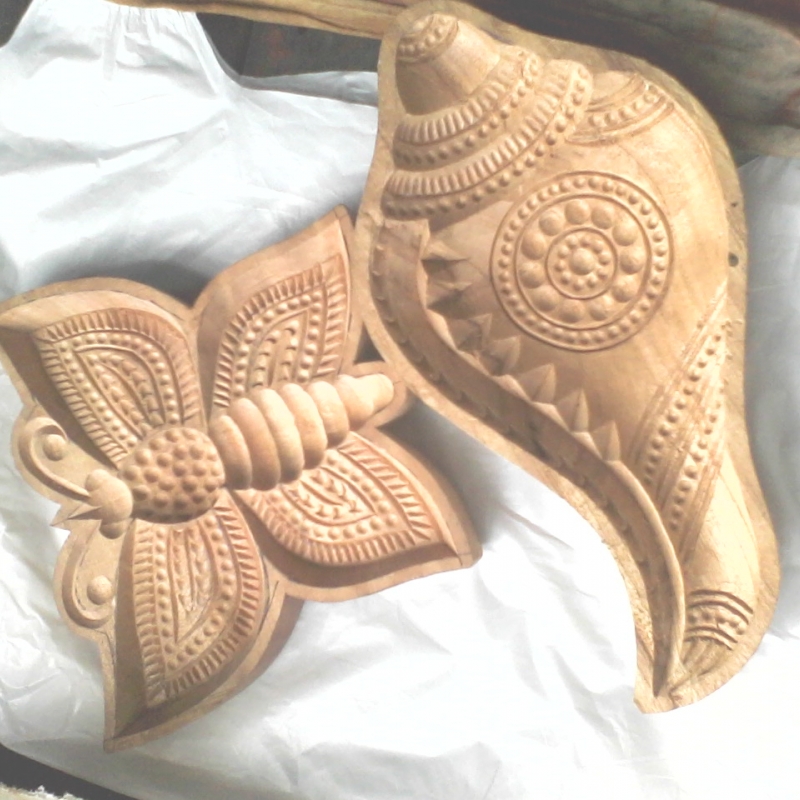One of the oldest engravings on earthen pots in Bengal can be found in an archaeological site named Pandu near Burdwan. This archaeological sample reflects the designs that were part of ancient clay art. In one of the designs there is a fishing net with fishes engraved on a clay pot. This design shows that fishing was an important source of livelihood and it was an important food item. Most of the crafting of moulds was done by women. Most of the designs engraved on moulds could be read as a reflection of everyday life that existed in different time periods. Therefore, it is no coincidence that some of the designs, shapes or sizes are not available anymore and the base material has also undergone a shift. Presently, moulds used for the sweet industry are made of wood. However, if we look back we find evidences of moulds made of clay and stone as well. Some of the moulds from 19th-century Bengal can be seen in the photo-essay on moulds.
One cannot understand the art of crafting moulds until and unless one has a deeper understanding of the history and evolution of folk art. Most indigenous artefacts were mainly for everyday use, and though it lacked sophistication, we find a rich artistic sensibility in its experimentation with form and designs. Interestingly, indigenous art is both an imitation as well as a vehicle of representation of the contemporary society, economy and religious customs and beliefs. The geographical position and agro-based economy was also responsible for the celebration of indigenous folk art. The role of rituals and the symbolism of these art forms can be extended to indigenous artworks which find expression in art forms such as nakshi kantha (a kind of stitch indigenous to Bengal), pata chitra (scroll paintings), alpana, and otherwise in designs. What is significant to note is that all these art forms were part of an everyday life. Some art forms have undergone an interesting transformation in terms of its use, particularly nakshi kantha and scroll painting. Alpana—designs made from rice flour paste on floor of temple premises, floors or marriage premises—is still in vogue. In other words, indigenous art forms have been improvised and has inspired designs on several merchandises—mugs, T-shirts and so on.
Most of the raw materials used for indigenous art forms are leftovers, or materials of everyday use. In some cases, the base material is suited to its use. For instance, in case of moulds there are three primary base materials—stone, clay and wood. Two of the most commonly available ingredients from which moulds were made in households were stone and clay. Women took a lead role in the craftsmanship of art forms such as nakshi kantha or alpana and it was no different in the case of moulds, particularly those prepared from clay or stone.
Stone-based moulds were primarily used for making a commonly prepared household item from mango pulp—amsatta or dried sheets of mango pulp. This delicacy, adorned with delicate designs created using the moulds were exchanged as gifts, pleasantries and eaten in everyday Bengal. One may ask from where women accessed stone. As mentioned before, like most art forms, moulds too were prepared from leftovers. It would be important to note that it is a common practice in Hindu households to serve daily offerings to gods and goddesses on stone plates. Once the stone plates would wear out due to daily use or get chipped these became the base material for women to experiment with their artistry. With the aid of a sharpened knife, women would engrave designs on the stone plates. Considering these were used plates it had the depth and volume and it is not a coincidence that most of the amsatta moulds are bigger in size compared to the moulds that were prepared for sandesh.
Sandesh, as is known, is prepared from chhana (curd cheese). After the chhana paste is ready, moulds are used to give different shapes and sizes to the sandesh. The designs are crucial as most sweets are named after their designs, for instance komola sandesh is named thus to denote the fruit, komola or orange, it is shaped like, similarly aam sandesh is shaped like mango and so on. Another common ingredient used in homemade sweets is coconut. Coconut-based sweets of different shapes and sizes were served to guests and also consumed as snacks. It is believed that women prepared ornate moulds for such sweets. One of the most popular sweets in this repertoire is chandrapuli, chandra meaning moon. Half-moon-shaped moulds with ornamental patterns are used to give shape to this coconut-based sweet. Today, women rarely carve designs on clay and wood. However, there are artisans who display their craftsmanship through ornate designs of lotus, butterfly, fish, floral patterns and other patterns on clay and wood at ease. Clay-based moulds are mostly to be found in local fairs and wood-based moulds are found in a row of shops in Notun Bazaar, Kolkata.
Apart from a lane in North Kolkata and local fairs, the art of making moulds in households is a rare phenomenon. The collections in Gurusaday Museum, Joka, Kolkata[1], tell us of the rich tradition of undivided Bengal. Some of the collections date back to the 19th century. The entire collection has been divided on two lines: design-based and script-based. This tells us that since sweets were usually used to wish and exchange pleasantries, the moulds had to reflect that sensibility. Therefore, we find evidence of several messages written in Bangla script on moulds along with designs. Almost no lifecycle ceremony is complete without sweets, therefore engravings on the moulds included names of ceremonies pertaining to wedding such as ‘Gatraharidra’-etched sandesh for turmeric ceremony, ‘Fulsajya’/ ‘Milan ratri’-etched sandesh marking the night of consummation of marriage, messages wishing the couple ‘Subho Bibaho’ (happy marriage), ‘Shukhey Theyko’ (wishing you well), etc.
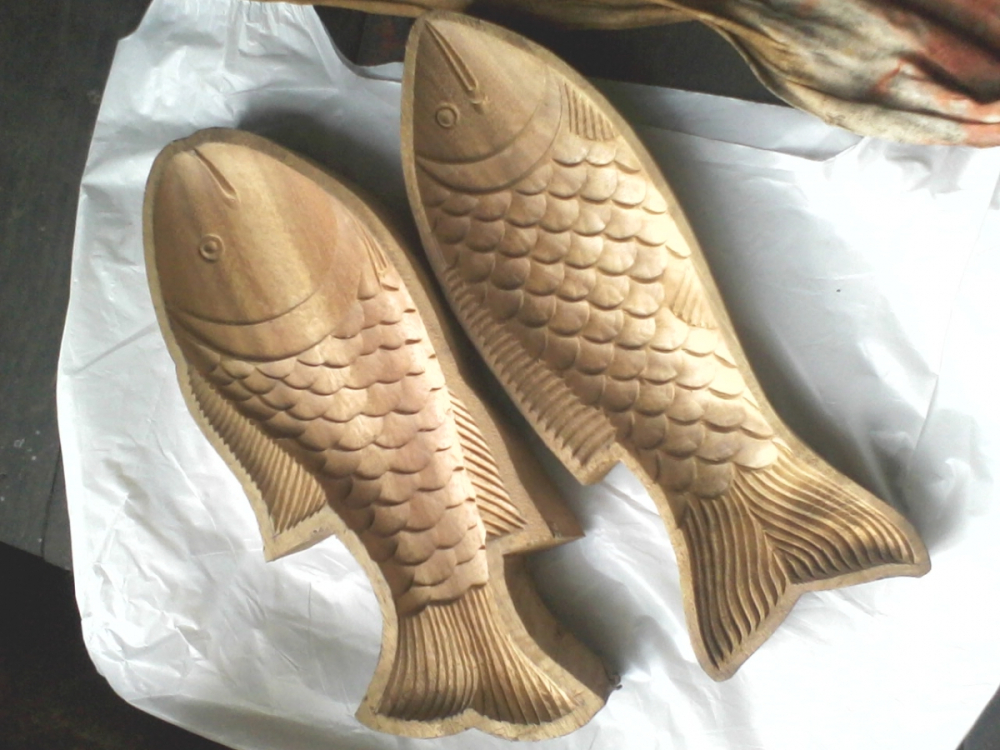
Fish is a common symbol in tatwa sweets. ( From the private collection of designs by Jayanta Das )
The mould engraved ‘Gatraharidra’ would also have ornate designs resembling flowers, fruits, leaves, animals, birds that were symbolic and considered auspicious during marriage. Other celebratory occasions were also marked in mould engravings. There are moulds with the engraving of ‘Bande Mataram’ marking the ongoing nationalist struggle. While there were patrons marking the nationalist struggle, there were several attempts to please the British rulers as well. Artisans created moulds like deer, gramophone logo, a British woman sitting on a chair or a British man smoking his pipe, etc. The mould designs also bear semblance with Kalighat painting, particularly a mould with an engraving of a cat with its catch (a prawn). Other interesting motifs are that of a monkey having a sweet cake. Designs are inspired from life, patron requests and other folk arts as well. The designs of the moulds are a reflection of the life and times of the period it belongs to. What is significant is the craftsmanship of women across households to prepare moulds from leftovers. If they displayed dexterity in their craftwork on used stone plates for amsatta moulds, the craftsmanship on clay moulds is an example of their aesthetic sensibility. It is a difficult task to work either with clay or with stone, more so with sandesh moulds, some of which are on display in the Gurusaday Museum or the clay moulds available near Kalighat Temple.
One of the striking components of the clay mould is the colour. From a distance one might mistake it for granite. However, a closer look will reveal that its clay. Clay-based moulds were mostly used for sandesh. Firstly, a soft lump of clay was given the shape of a plate. The design had to be engraved on the soft base and left in the sun to dry. Designs were mostly made with a sharp pointed object made from bamboo (kabari). A layer of banak (a specially made paste from a special variety of clay) was applied after the designs were etched. Banak was responsible for the different shades of clay. The clay for banak was carefully chosen from specific banks of rivers and or canals. Mostly men were responsible for collecting this clay. Potters made use of this clay in their work. After the clay is collected it is specially stored, processed and made ready for use. After applying the banak, the dried clay moulds are kept in the furnace for up to five hours. A specially prepared fuel base is used for this process. Cow dung cakes are preferred and the clay moulds are kept in the furnace so that the colour deepens. Potters prefer to leave the clay moulds for 10 to 12 hours after the fire is extinguished. It allows for a deepening of the colour. What is interesting is that these clay moulds were preferred for domestic use and hence its size varied depending on the celebration. Clay moulds can be used for both chhana- and coconut-based sweets.
Though clay moulds that are sold in fairs are made by male artisans, it is important to note that, like many folk arts, engraving moulds was considered to be a leisurely activity for women. However, wooden moulds are preferred over clay in commercial production of sweets. Sweetshops across Bengal, in fact across India, buy wooden moulds from Notun Bazaar. Interesting motifs and designs adorn the trays of moulds of different sizes.
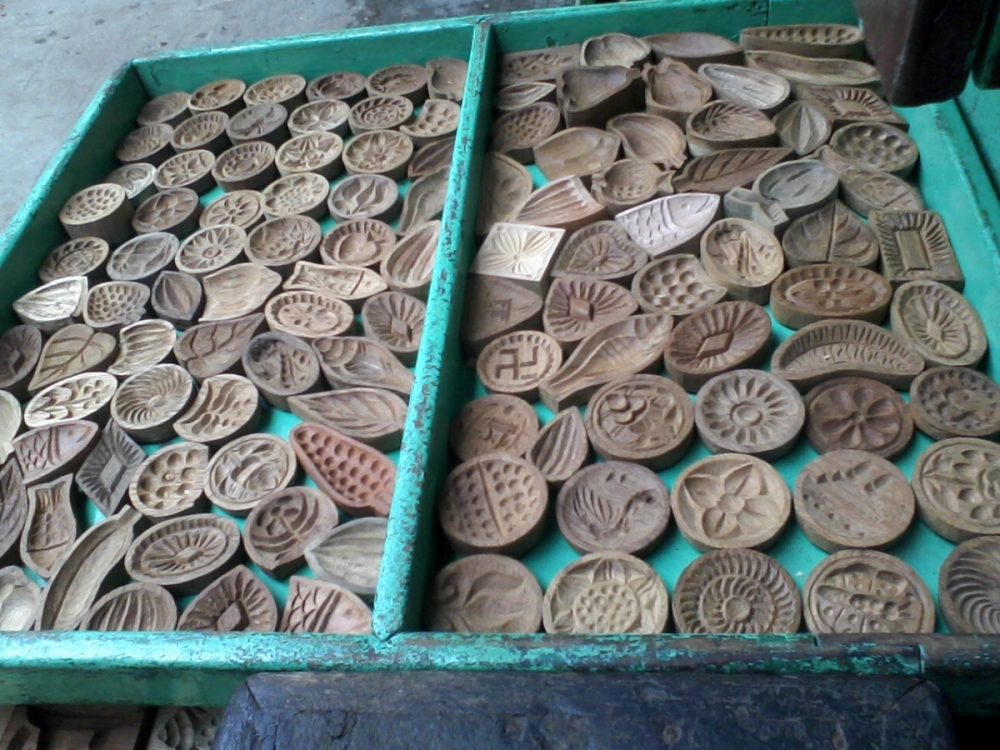
Moulds of different sizes on display in a shop in Notun Bazar, Kolkata. Customers of these moulds would be sweetshop owners as well as home cooks interested in making sweets.
(From the private collection of designs by Jayanta Das )
Usually shopkeepers double up as artisans. There are primarily three kinds of moulds that are prepared and sold here. Firstly, moulds for everyday use. These moulds are bought by shopkeepers for everyday use. These moulds can vary in sizes. Usually negotiations about price depend on the design and the weight of the chhana a mould can carry. Secondly, specially engraved moulds for tatwa-based sweets is a huge attraction. Tatwa is the gift exchanged during weddings. In this gift exchange, sweets shaped like bride and groom, deer, butterfly, peacock and fish are a common sight. These moulds are comparatively big in size.
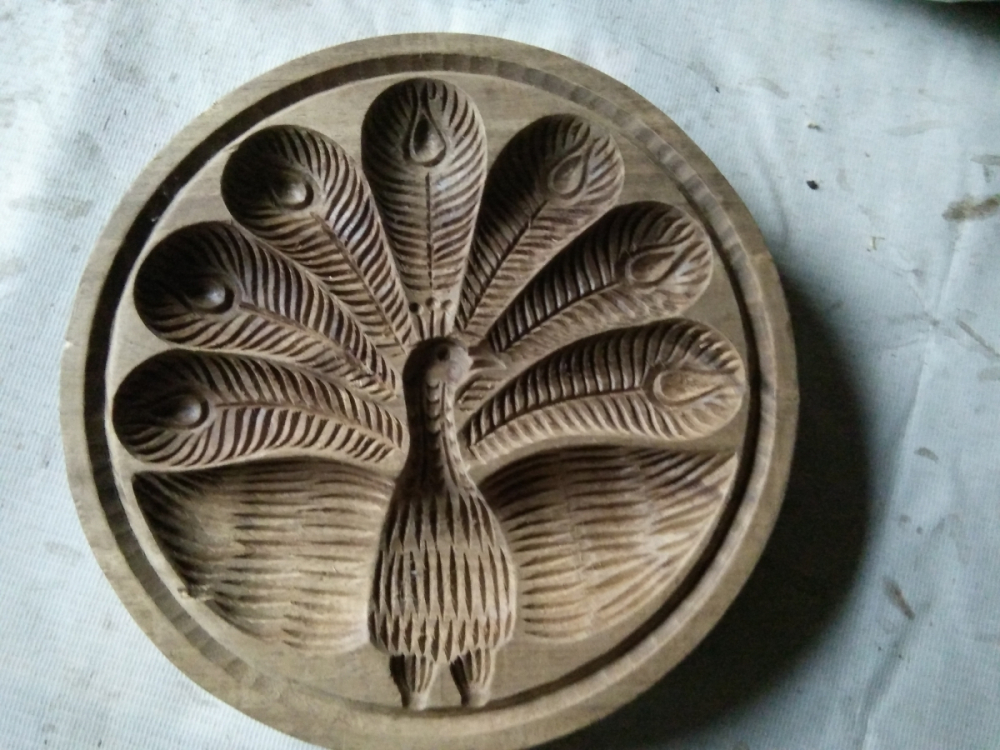
This disc shaped mould would be used for special occasions such as wedding. The ornate design of peacock is an unique design used in Tatwa sweets
(From the private collection of designs by Jayanta Das)
There are also moulds that are sold with messages for the bridge and groom or to commemorate other festive occasions such as Diwali (‘Subho Dipabali’) or Brother’s Day (‘Bhain Phonta’) or greetings exchanged after the idol of Goddess Durga is immersed (‘Subho Bijoya’).
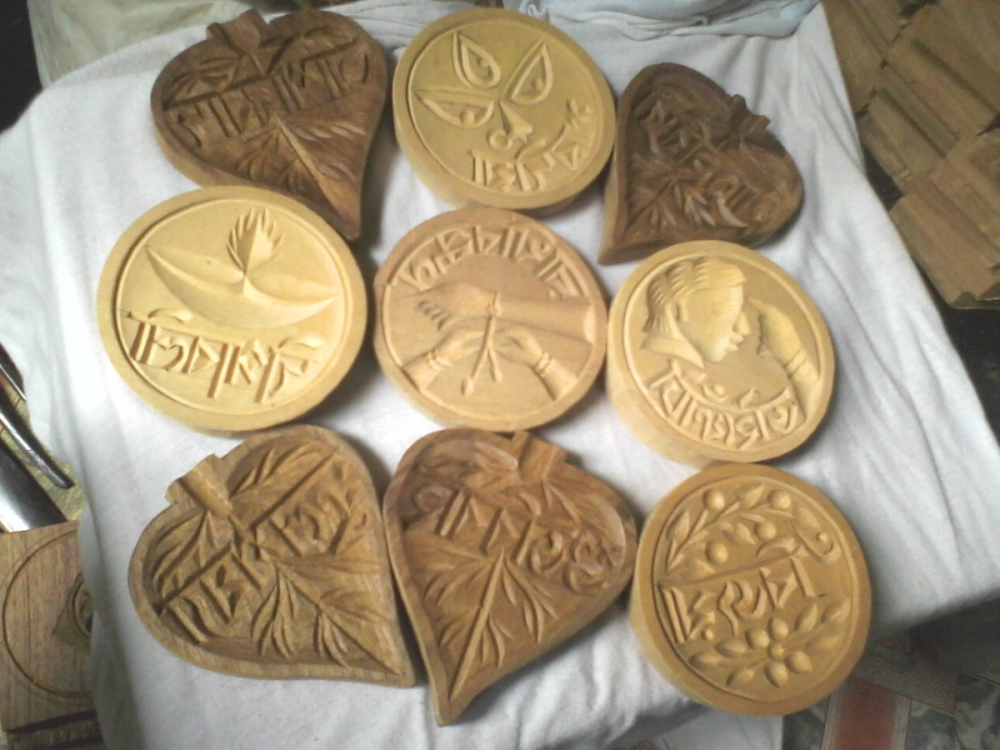
Moulds embossed with greetings for occasions in the Hindu ritual calendar
(From the private collection of designs by Jayanta Das)
Taking cue from such celebrations, it is not uncommon to spot company logos on moulds. This informs the third variety of moulds—what one can call moulds prepared on request. Such moulds are specially designed and can also be used to denote political party symbols to celebrate the victory of the winning party in an election.
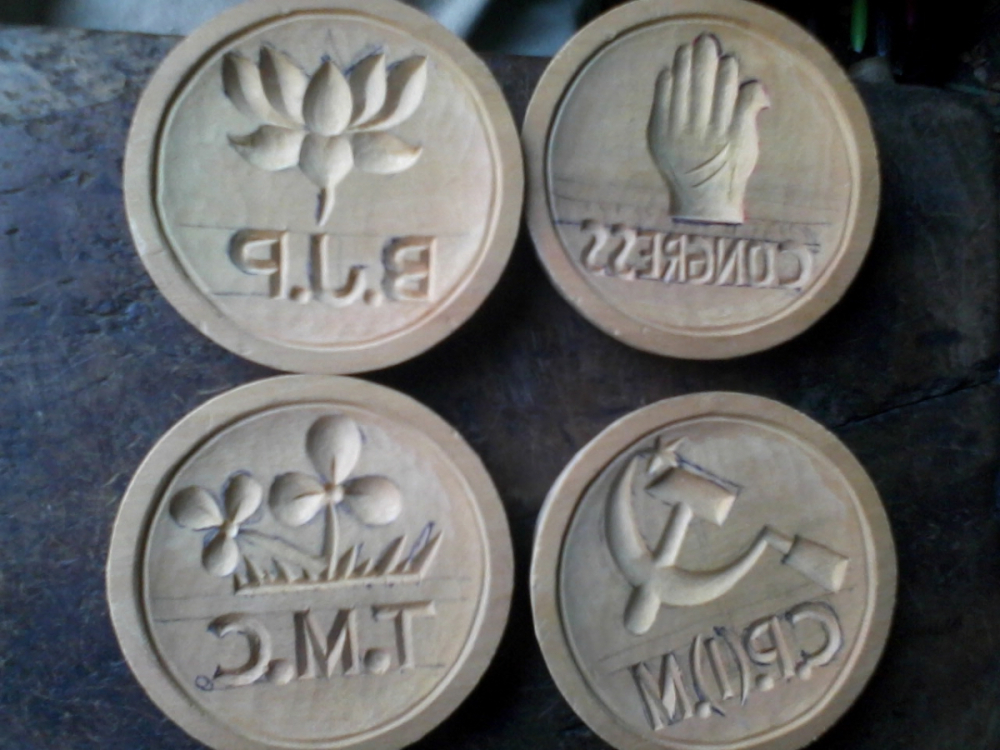
Various party symbols adorn moulds during elections. It is a custom to wish the winning candidate with boxes full of sweets with party symbols
(From the private collection of designs by Jayanta Das)
To conclude it may be said that though one can find evidences of moulds prepared from three kinds of materials—stone, wood and clay—it has become a rare sight to find moulds prepared from stone. Not only have stone-based moulds disappeared but so has ornamental amsatta. Today amsatta is sold as a rectangular block of sheets packaged in transparent wraps with names of local manufacturing companies—a packaging far removed from the ornamental designs created using moulds that one sees in the collection in Gurusaday Museum. The designs of moulds nowadays bear proof of the evolution of the consumption tastes of sweet eaters and therefore it is not uncommon to spot sweets shaped like a strawberry, kiwi—fruits that are not indigenous to Bengal. Finally, wooden moulds are preferred over clay moulds because of their shelf life.
[1] http://www.gurusadaymuseum.org/; Accessed on February 25, 2017.
